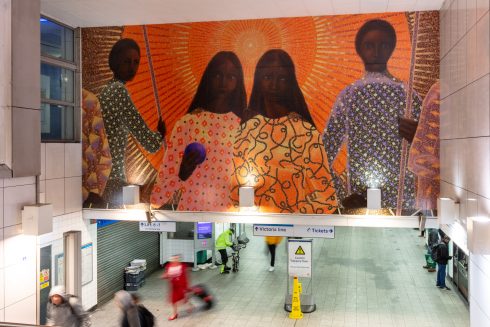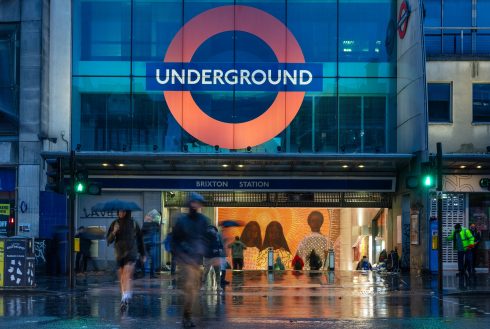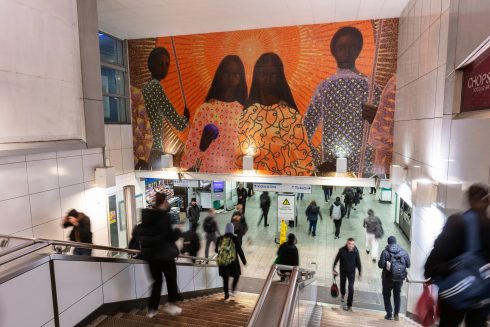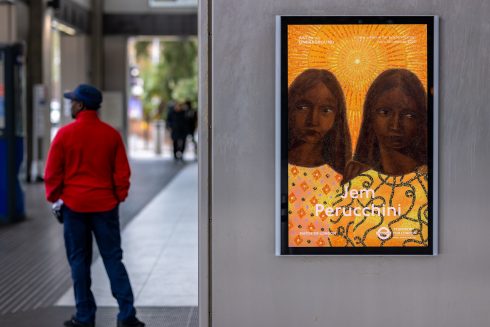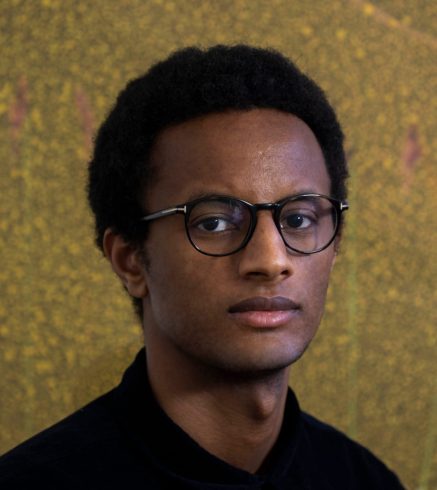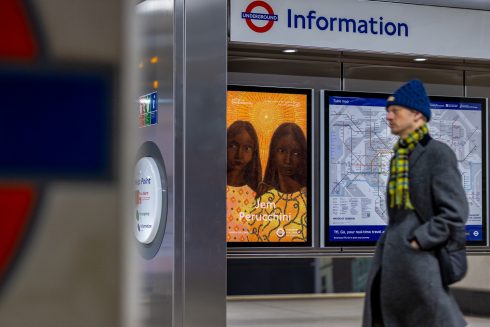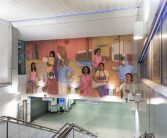Art on the Underground is pleased to present a new artwork by Jem Perucchini at Brixton Underground station from November 2023, marking the Italian artist’s first major commission.
Titled Rebirth of a Nation, the large-scale public artwork will be on view for a year and is the latest in a series of commissions for the station, following on from the work of artists including Njideka Akunyili Crosby and Joy Labinjo. Initiated in 2018, the programme invites artists to respond to the diverse narratives of the area, in recognition of the local murals painted in Brixton in the 1980s.
Born in Ethiopia but based in Italy since childhood, Perucchini is powerfully influenced by Italian art history. Conjuring the Early Renaissance with his distinctive, richly detailed painting style, his new work for Brixton station captures ethereal figures with luminous light. The composition is an allegorical vision in which the past, embodied by a female figure, and the future, her mirror image, meet. Flanked by two men holding spears, the women are distinguished by their sumptuously decorated clothes. One clasps a purple orb; historically a symbol of sovereign power in painting iconography. The elaborately detailed fabrics are evocative of African wax cloth, a material interwoven with the skill, artistry and identities of the diverse African diaspora. Bathed in the rays of a rising orange sun, the four figures inhabit an otherworldly environment of irregular compositional perspective, imbued with warm hues and a meditational quality that is evocative of a Renaissance altarpiece.
For this new work Perucchini maintains a strong connection to his practice, focussing on the active role of Western art history in the construction of archetypes. Certain representative figures dominate the art historical canon, and traditionally hold distinct positions in the social and symbolic hierarchy. Mining for overlooked narratives, Perucchini’s compositions are both familiar and enigmatic, and reimagine how the fantasies of the past can impact on the realities of the present.
This work’s inspiration is drawn from the Ivory Bangle Lady, the name given to the occupant of an ancient grave dated to around the 4th century. The Ivory Bangle Lady was of North African origin; her grave was found in York. The stone grave contained rare, imported objects and valuable jewellery, one of which was an elephant ivory bangle. These objects indicate that she was amongst the richest inhabitants of the region and enjoyed a high social status. Other archaeological finds also support the theory that African people had a place in the upper echelons of Roman society, suggesting that early Britain may have been more ethnically diverse than mainstream history suggests. Perucchini’s reference to this rich cultural past underscores how history can be seen and interpreted from multiple viewpoints and charges the work with questions about the hierarchy of narratives, the construction of national identity and how some histories are privileged, whilst others are erased.
Drawing from Brixton, one of London’s most distinctive areas, Perucchini’s work responds to an environment shaped by its diverse residents and their histories. As a nucleus for Black British history, the area has been shaped by recent social and political movements. In post-war London many West Indian immigrants settled in Brixton – almost a third who travelled on the Empire Windrush made it their home – and it quickly became a centre for the Black community. Perucchini’s work challenges the notion that Black British history stretches no further back than the 20th Century, celebrating the long lineage of Black Britons who came before and pointing towards an equally glorious future, set within a divine and timeless world.
Jem Perucchini stated: “For me, Brixton represents a microcosm of London, a place where the community creates a local focus. The Underground station then acts as the main pivot between the centre and the periphery, the inside and the outside of the city. Working on this project has been very stimulating, not only for the opportunity to see my work reproduced in such a large format, but also because of its location in the heart of Brixton, visible by all its inhabitants and those who pass through it.”
